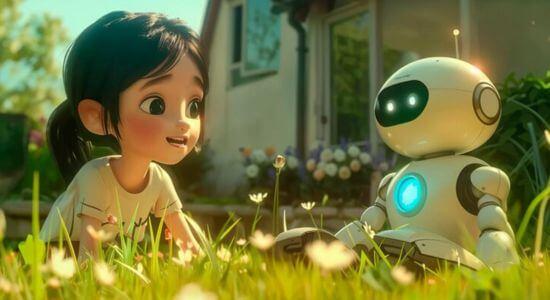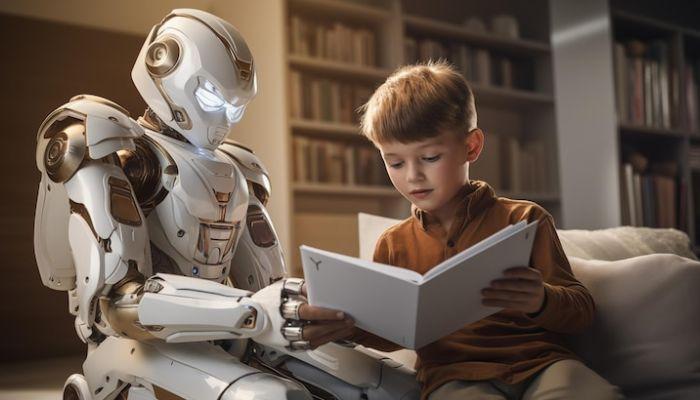In today’s digital age, tech is changing the way kids learn and even the way they read. Some of the most exciting developments are things like kids book AI, a new fusion of science and storytelling that is already changing children’s literature. From personalized stories to interactive learning tools, kids book AI is making the bedtime story a smarter, more engaging and truly personal experience.
In this deep-dive article, we will look at what Kids Book AI is, how it operates, the benefits of the technology, the key players in the space, potential challenges and how parents and educators can best leverage this technology.
What is Kids Book AI?
Commonly refers to artificial intelligence-based software tools or platforms that are used for creating children’s books, personalizing or enhancing them. The systems rely on natural language processing, machine learning and sometimes wacky algorithms to churn out stories, illustrations and interactive features that are likely to appeal to young children. Unlike the old method, it enables very swift creation of stories, customization and flexibility and hence, it’s a game changer for the publishing industry.
For parents and teachers, it is a means of creating stories that meet a child’s interests, reading level or educational goals. For instance, a parent might enter their child’s name, their favorite animals or their hobbies, and it will produce a personalised story including these details. Such personalisation makes reading more interactive and empathic, nurturing affection for books at young ages.
Also Read: Motivational Stories for Students: Lessons That Will Inspire Hard Work
Why Kids Book AI is Gaining Popularity
Its success comes from its power to solve contemporary issues in children’s literature. With attention spans shortening and digital devices vying for kids’ time, the old-fashioned book is evolving to stay relevant. Here’s why it is making waves with parents, educators and publishers:
- Personalization: AI creates customized stories for the individual to facilitate kids as the hero of their very own adventure. This intimate nature of the text adds engagement and emotional attachment to the story.
- Accessibility: Enabled by AI-powered platforms, adults can access age-appropriate content instantly rather than searching through bookstores or libraries. Many tools are accessible on the internet, with an immediate download or a form of ready-to-print book.
- Educational Content: Many platforms include learning objectives, such as vocabulary building, moral lessons stories, or STEM elements, in their stories. These make for great tools for educators who want to infuse learning with fun.
- Cost-efficient: Publication of a children’s book generally requires a writer, an artist, and a publisher, all of which are clearly costly. This AI tool slashes these costs by automating a lot of the process, rendering it affordable for families and small publishers.
- Speed and Scalability: With this technology, the creation of all-in-one books with varied topics can be done in minutes. Which is perfect for classrooms or a home school setting where multiple narratives are provided.
How Kids Book AI Works
Understanding how it works allows a fair appreciation of its functionality. The typical platform is based on manual inputs followed by AI algorithms. Here’s a simple breakdown:
- User Input: Parents or teachers enter information like the child’s name, age, interest, or theme (space, animal, fairy tale, etc). On some platforms, users can even adjust reading difficulty or moral lessons.
- Story Generation: With the help of NLP and Generative AI models, AI tells a story from the input. They are trained on big datasets of children’s books to make sure the stories and the themes involved in them are appropriate and engaging.
- Illustration Generation: A few platforms come with image-generation support, helping you design illustrations to go along with your text. These are typically created with the help of AI image art tools and make for colourful, interesting patterns.
- Output Delivery: The output, which is a story, an e-book, or a printable PDF, is then delivered to the user. Other features, such as interactive media, auto-play audio narration or augmented reality (AR) elements, enrich the reading experience.
- Feedback and Refinement: Advanced platforms get better the more they are used, leverage user feedback to hone their craft, and add new elements of personalization to their mechanism of storytelling.
This frictionless experience means it is a flexible tool for generating high-quality children’s books in a short amount of time.
Benefits of Kids Book AI for Children

It has a lot to offer for little readers and helps as a helpful resource in the contemporary way of education and entertainment. Here are some key benefits:
- Greater Engagement: Through names and favorite themes, it generates stories that children feel are personal and fun. This can ignite a love of reading for life.
- Diverse: Kids Book AI can create stories that represent diverse cultures, experiences, and abilities; so that no child feels left out when reading a book.
- Skill Learning: Some more elements from the stories of Kids Book AI contain educational properties such as phonics, math, or social-emotional learning, teaching children valuable skills.
- Promoting Creativity: A handful of apps let kids supply ideas or guide the course of the story, which can inspire creativity and critical thinking. This interactive feature is one of the signature element of these platforms.
- Screen-Time Balance: Kids Book AI may be a digital experience, but it promotes reading as opposed to an inactive screen activity, an excellent compromise for children who may otherwise play games or watch videos.
Also Read: Top 10 AI-Powered Mobile Apps You Need to Try Today
Applications of Kids Book AI in Education
Educators are also using this AI tool to supplement the learning experience in the classroom. It can be used as a teaching tool in many types of educational environments, from preschools to elementary classrooms. Here’s how it is being used in education:
- Personalized Reading Material: Teachers can use Kids Book AI to create stories that meet their needs. So, for instance, a science teacher could create a narrative about a kid travelling through the solar system.
- Language Learning: This AI can produce stories in many languages to assist in teaching bilingual kids or second language learners. For children learning literacy, this is particularly advantageous.
- Special Needs Education: For children with learning disabilities or special needs, this tool can simplify stories or provide sensory-friendly features like accessible fonts or audio narration.
- Classroom Projects: These platforms can organize collaborative storytelling projects in which students input ideas, and then the AI develops a completed story. This encourages collaboration and creativity.
- Homeschooling Support: Homeschooling Parents use AI to write fun, curriculum-aligned stories, thus saving time and resources and, keeping the lesson fun.
Kids Book AI for Parents
For parents, it is a game-changer for bedtime storytelling or reading time. Here’s how parents can use it:
- Personalized Bedtime Stories: Parents can story-craft their tales featuring their child as the star to help with winding down at bedtime and transitioning to bedtime from other activities. It makes sure that the content is unique and cool.
- Gift Ideas: A custom book created with AI is a special gift for birthdays or holidays that becomes a memory the child will treasure.
- Motivating Reluctant Readers: For children who struggle with reading, AI generates stories based on children’s interests, thereby reducing the intimidation factor, as well as maximizing the fullness of reading.
- Portable Content: Many platforms also offer digital or printable stories ideal for unbiased, screen time-free entertainment during long journeys.
Ethical Considerations in Kids Book AI
While it offers great potential, it’s important to address ethical considerations for responsible use:
- Quality of Content: AI authored stories should be suitable for the age group should not be biased or have unhealthy themes. A content filter is a must for developers of Kids Book AI.
- Data Privacy: Most platforms ask for personal data, like a child’s name or interests. Parents should select services with robust privacy policies for data protection.
- Balancing AI and Human Creativity: While its powerful new machine-learning model, it’s not designed to be a replacement for human-authored books. Finding a balance between AI-generated and traditional stories helps keep children’s literature diverse.
- Accessibility and Equity: Developers are to make sure that these applications are affordable and not just an application for those who can afford them but for all families from poor to rich to ensure a bridge between the haves and the have-nots.
The Future of Kids Book AI
The prospects look positive as further developments in AI technology will lead to the development of even more amazing capabilities. Here’s what to watch:
- Interactive Storytelling: Future platforms can incorporate the below features AR or VR, where children can interact with the stories applied for a 3D story world.
- Voice-Activated Stories: Since voice commands are now increasingly used for smart assistants, Story AI could potentially allow children to describe stories with voice commands, an even more natural input.
- Multilingual Expansion: As AI continues to grow, it should be able to expand even further by adding additional languages and dialects, allowing kids from everywhere to enjoy their own stories.
- EdTech integration: AI could be integrated through platforms that are used in the classroom or at home, providing real-time analytics and understanding of a child’s reading characteristics or comprehension.
- AI-Human Collaboration for Story Telling: In the future, authors may be able to co-create with Kids Book AI, thus mixing the best of AI and Human brain effectively.
Challenges of Kids Book AI
However, for all of its promise, it has some hurdles it will need to overcome if it hopes to become more fully adopted:
- Quality Control: Maintaining grammatical correctness, coherence, and writing style of AI-generated stories is a hard problem requiring substantial tweaking of the algorithms.
- Over-Reliance on Technology: Parents and teachers have to balance kids book AI and traditional reading experience for the right amount of literary exposure.
- Cost: Kids Book AI is usually relatively inexpensive, but some premium features or subscription costs may be expensive for some families.
- Cultural Sensitivity: Kids Book AI must learn to avoid stereotypes and respect cultural nuances as it tells its stories so it’s inclusive.
How to Choose a Kids Book AI Platform
You have so many platforms but choosing the right one is challenging. Here are a few criteria for selecting a dependable platform:
- User Experience: Search for platforms that have easy-to-use interfaces that allow for easy data inputs and produce stories.
- Customization Options: Look for a tool with customization features like adjustable reading levels or theme variety.
- Safety and Privacy: Ensure that the platform maintains privacy and does not store sensitive data without user consent.
- Output Quality: One has to test how the platform outputs stories to see if they are enjoyable, well-written and visually appealing.
- Customer Service: Choose a site with good customer service to resolve problems, should they arise, or answer questions.
Conclusion
Kids Book AI is disrupting children’s books with personalized, approachable and educational stories designed to captivate young readers. Whether setting the stage for creativity or supplementing in-class learning, kids book AI shows parents, educators and children to explore new pathways for storytelling. With the ever-changing tech landscape, so does kids book AI, as we will be introducing new and exciting ways to challenge the imagination throughout a lifelong journey of reading. By embracing kids book AI, we can ensure that future toddlers have stories as cool as they are and as diverse as the world they experience.
FAQs
Q1: What is the age range of Kids Book AI?
Most target kids between the ages of 3 and 12. Please always read age recommendations and sample the content.
Q2: Can Kids Book AI take the place of traditional books?
No. You should think of it as an enhancement of printed books and storytelling, not as a replacement.
Q3: Should I feel safe sharing my child’s data on these apps?
Only rely on reputable, well-reviewed apps that have transparent privacy policies. Anyone you don’t know, don’t describe in detail and don’t provide your personal and sensitive information.
Q4: Are kids able to write their own stories with Kids Book AI?
Yes! A lot of platforms are incentivizing kids to be co-creators and to be creative and expressive in that space.
Q5: Are there any free Kids Book AI apps?
Yes, some apps are limited and have a free version. There are also free trials or educational offers from others.
Meta Description: Discover how Kids Book AI is disrupting children’s storytelling with personalized, interactive and educational reading experiences. Here’s what to know about its benefits, its tools and how to use it safely.



